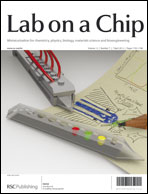Microfluidic system for simultaneous optical measurement of platelet aggregation at multiple shear rates in whole blood†
Abstract
Thrombosis is the pathological formation of platelet aggregates which occlude blood flow causing stroke and heart attack–the leading causes of death in developed nations. Instrumentation for diagnosing and exploring treatments for pathological platelet aggregation thus has the potential for major clinical impact. Most current thrombosis methods focus on single flow conditions, non-occlusive platelet adhesion, or low shear rates and so are limited in their application to comparative studies involving multiple, pathological test conditions (e.g., shear rate, stenotic geometries that mimic arteries, and rapid platelet accumulation to occlusion). The field could benefit from a low volume, high throughput, short analysis time, and low cost system while minimizing sample handling. We report on the design, fabrication, testing, and application of a microfluidic device and associated optical system for simultaneous measurement of platelet aggregation at multiple initial shear rates within four stenotic channels in label-free whole blood. Following computational design, requisite shear rates were achieved in the device by micro- surface milling a mold and subsequent PDMS casting. We applied the microfluidic system to measure platelet aggregation in whole porcine blood for shear rates spanning physiological to pathological flow conditions (500–13000 s−1). Real-time, non-contact, label-free, microscope-free measurements of platelet aggregation were acquired using an optical system comprising a 650 nm diode laser and a linear CCD. We observed fully occlusive platelet aggregation in less than 20 min above a threshold initial shear rate of 4000 s−1, and no occlusive platelet aggregation below 1500 s−1 (N = 86 trials). Accumulation of thrombus was consistent between laser intensity, light microscopy, histology, and mass flow rate measurements. The amount of blood volumes producing occlusion were dependent on shear rate. Times to occlusion were not found to be dependent on shear rate above the threshold level of 4000 s−1. This microfluidic system enables measurement of the entire process of occlusive platelet thrombosis in whole, unlabeled blood, in vitro, at multiple shear rates. Such a system may be useful as a point-of-care diagnostic tool for studying anti-platelet therapies in individual blood samples from high-risk patients.


 Please wait while we load your content...
Please wait while we load your content...